RDP 2017-04: How Australians Pay: Evidence from the 2016 Consumer Payments Survey 5. Cash
July 2017
5.1 Cash Payments
The share of consumer payments made in cash has fallen markedly over the past decade or so – to 37 per cent of the number of payments in 2016 from 69 per cent in 2007 (Figure 13). The main contributor has been an increase in the use of cards for in-person payments, although other factors have played a role. For example, between 2007 and 2013 an increasing share of consumer payments were made via ‘remote’ payment channels – e.g. online card payments. Between 2013 and 2016, the decline in the use of cash relative to other payment methods was almost entirely due to consumers using cards more frequently for in-person payments, as discussed above.

Source: RBA calculations, based on data from Colmar Brunton, Ipsos and Roy Morgan Research
Cash continues to be used more often for lower-value transactions – it was the most common way of making payments of $10 or less in 2016, accounting for over 60 per cent of these small payments. Consumers are, however, increasingly using alternatives to cash for lower-value payments. For example:
- The share of payments of $10 or less made in cash was 16 percentage points lower in 2016 than in the 2013 survey (33 percentage points lower than in 2007).
- The payment value at which cash is the most common means of payment has been falling over time. In 2016, this ‘threshold’ was $12, whereas cash was the most frequently used payment method up to $22 in 2013, and up to $41 in 2007 (Figure 14).
The shift away from cash to other payment methods has occurred across all types of merchants (Table 3). For most merchant categories, consumers now pay with cash less frequently than with cards. One exception is at food retailers – which includes specialty food stores, cafés, pubs and takeaway food outlets – where cash was used for 55 per cent of purchases in 2016. But this share has also fallen markedly in recent years; cash accounted for over 70 per cent of payments at food retailers in 2013. Consumers also tend to pay in cash relatively frequently for leisure and entertainment, transport and services – which includes items such as home repair, professional services and haircuts. But again, participants in the 2016 CPS paid in cash at these merchants less often than participants in 2013.

Note: $5-centred moving average
Source: RBA calculations, based on data from Colmar Brunton, Ipsos and Roy Morgan Research
The overall decline in the relative use of cash is consistent with both changing consumer preferences and a greater willingness of merchants to accept cards. For smaller businesses, such as cafés, the availability of contactless card terminals is likely to have increased the speed at which they can handle card payments, potentially lowering the overall cost of accepting cards.[20] Similarly, a reduction in interchange fees for small/contactless card payments by one of the international card schemes in late 2012 may have contributed to a greater willingness by some businesses to accept cards for low-value purchases (and may also have reduced the incentive to specify a minimum spend for card transactions); see Reserve Bank of Australia (2013).
For merchants such as supermarkets and petrol stations, recent changes in the payments mix are more likely to be explained by consumer payment preferences than merchants' acceptance decisions. Supermarkets, for example, were among the first merchants to routinely accept contactless card payments, with Coles and Woolworths engaging in an extensive rollout of contactless terminals across their stores well before the 2013 survey.[21] Accordingly, the decline in relative cash use at supermarkets – 7 percentage points between 2013 and 2016 – is consistent with an increasing share of shoppers preferring to pay by card (changes in technology, such as the rollout of self-service checkouts, are likely to have also played a role).
The decline in cash as a share of payments was also observed across different demographic groups. Respondents of all ages, income groups, and locations used cash less frequently, on average, in 2016 than participants in previous surveys (Table 5).[22] But there are still some significant differences in the relative use of cash among different segments of the population. Most notably, cash remains the most common payment method for respondents aged 65 and over, who made around half of their payments in cash in 2016. In contrast, cash was used for less than one-third of payments made by respondents aged under 40. The survey also suggests that lower-income households tend to use cash more intensively than households in the highest income quartiles.[23]
| 2007 | 2010 | 2013 | 2016 | ||||||||
|---|---|---|---|---|---|---|---|---|---|---|---|
| Cash | Card | Cash | Card | Cash | Card | Cash | Card | ||||
| Age (years) | |||||||||||
| 18–29 | 67 | 29 | 58 | 33 | 44 | 47 | 31 | 58 | |||
| 30–39 | 61 | 33 | 54 | 37 | 40 | 47 | 28 | 59 | |||
| 40–49 | 68 | 27 | 57 | 35 | 47 | 43 | 36 | 53 | |||
| 50–64 | 72 | 24 | 66 | 28 | 48 | 41 | 42 | 48 | |||
| 65+ | 78 | 18 | 73 | 21 | 60 | 33 | 51 | 40 | |||
| Age-adjusted household income | |||||||||||
| 1st quartile | 72 | 22 | 67 | 24 | 49 | 39 | 44 | 44 | |||
| 2nd quartile | 69 | 26 | 59 | 33 | 50 | 39 | 43 | 45 | |||
| 3rd quartile | 70 | 25 | 59 | 34 | 49 | 41 | 38 | 51 | |||
| 4th quartile | 63 | 32 | 59 | 34 | 43 | 49 | 32 | 58 | |||
| Location | |||||||||||
| Regional | 70 | 25 | 62 | 30 | 51 | 39 | 44 | 46 | |||
| Capital city | 69 | 27 | 61 | 32 | 46 | 44 | 34 | 55 | |||
|
Note: Excludes payments over $9,999, transfers (payments to family and friends) and automatic payments Source: RBA calculations, based on data from Colmar Brunton, Ipsos and Roy Morgan Research |
|||||||||||
Although the share of consumer payments made in cash has declined across the board, there is evidence of a widening dispersion in the use of cash across the community. That is, the switch away from cash recorded in the 2016 CPS was more pronounced for demographic groups that tended to use cash the least frequently in 2013 than it was for groups of relatively frequent cash users. For example, the share of payments made in cash by consumers aged under 40 fell by 13 percentage points between 2013 and 2016, compared with a fall of 8 percentage points for older consumers. Similarly, higher-income consumers have switched away from cash towards cards at a faster rate than respondents with lower incomes in recent years.
A wider dispersion is also evident at an individual level. The standard deviation of individual respondents' relative cash use (measured as a share of all in-person payments) increased to 34 percentage points in 2016 from 30 percentage points in 2013. Relatedly, the share of respondents who used cash for less than 20 per cent of their in-person transactions doubled between 2013 and 2016, to nearly one-third (Figure 15). Within this group, the share of survey respondents that did not use cash at all in the diary week more than doubled between 2013 and 2016, to 18 per cent. Meanwhile, there was little change in the share of consumers that use cash very intensively – one-fifth of respondents continue to use cash for more than 80 per cent of their transactions, compared with one-quarter in 2013. Within this group, around 12 per cent of respondents in both 2013 and 2016 reported paying in cash for all of their in-person transactions in the survey week.

Source: RBA calculations, based on data from Colmar Brunton, Ipsos and Roy Morgan Research
Despite the trend decline in relative cash use, there are a variety of reasons why people continue to use cash for their transactions. When asked about the most important reason for using cash in the 2016 CPS, the responses were fairly evenly split between those that relate to merchant acceptance and those relating to respondents' own preferences and habits (Figure 16). The most common response, cited by 19 per cent of participants, was that merchants did not accept alternative payment methods or had minimum spend requirements. A further 16 per cent of participants reported a desire to avoid card surcharges, while 7 per cent cited discounts for cash use. Relating to their own preferences and habits, respondents indicated a preference for using cash in small transactions (18 per cent of respondents) and a preference for using their own funds or to use cash as a budgeting tool (14 per cent). A smaller share indicated that fraud and privacy concerns were their most important reasons for using cash.
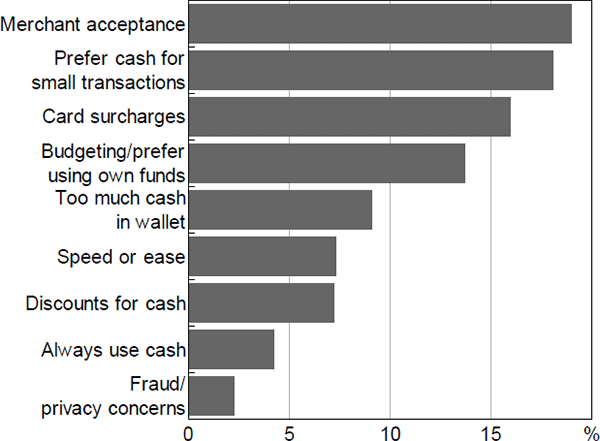
Source: RBA calculations, based on data from Ipsos
For the participants who used cash the most intensively, consumer preferences were more prominent than factors relating to merchant acceptance. As an illustration, people who used cash for 80 per cent or more of their in-person transactions were more likely than other respondents to report that they prefer to use cash as a budgeting tool, prefer using their own funds, or view cash as more convenient (Figure 17). Conversely, respondents who used cash relatively infrequently (for less than 20 per cent of their in-person transactions) were more likely to cite reasons related to merchant acceptance and price incentives at the point of sale.
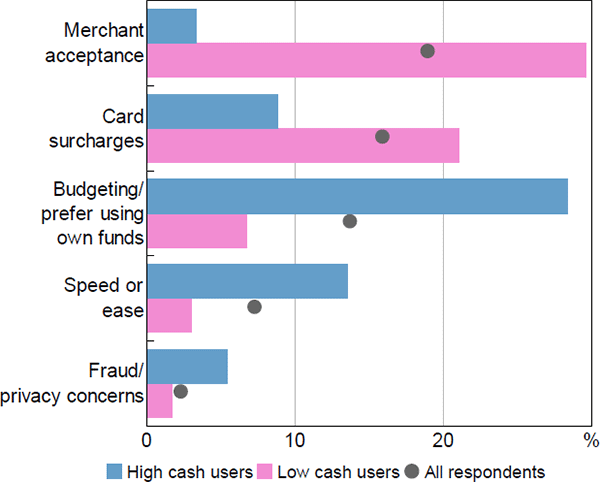
Notes: Selected reasons; frequency based on share of point-of-sale payments in cash (low: <20 per cent, high: ≥ 80 per cent)
Source: Source: RBA calculations, based on data from Ipsos
5.2 Cash Holdings
Consistent with the decline in transactional use of cash, the median value of cash held in consumers' wallets or on their person fell to $40, from $55 in 2013. But there was a wide dispersion across participants in the amount of cash carried in their wallets, with a standard deviation of $199 in 2016, compared with around $180 in 2013 and 2010. Around one-fifth of respondents did not hold any cash at the beginning of the survey week (compared with 8 per cent in 2013), while around one-third held more than $100, a similar share to the 2013 survey.
Respondents that used cash most often for transactions also tended to hold more cash. For example, the median respondent aged 65 and over held $95 in their wallet at the beginning of the survey week; more than twice as much as the value of cash held by people in other age groups (Figure 18). The main reason given by respondents for holding cash in their wallets, other than for day-to-day transactions, was for precautionary purposes (i.e. to fund emergency transactions).
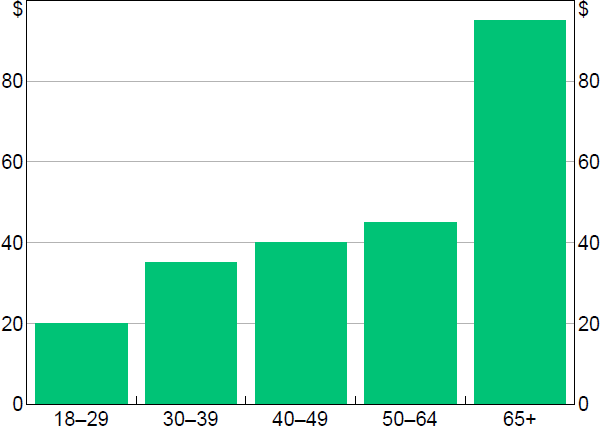
Source: RBA calculations, based on data from Ipsos
In 2016, around 70 per cent of survey participants reported also holding some cash outside of their wallet, compared with about 75 per cent in 2013. While the majority of respondents in 2016 reported that they typically held $100 or less outside of their wallet, around one-quarter typically held between $101 and $1,000, and only a small share (around 3 per cent) reported holding over $1,000 outside their wallets.
For the first time in 2016, respondents were asked about their reasons for holding cash outside of their wallet separately from their reasons for holding cash in their wallet.[24] As with cash held in wallets, the most common reason was for emergency transaction needs (Figure 19). A smaller but still significant share of respondents (26 per cent) cited issues relating to the accessibility of cash – such as automated teller machine (ATM) fees and access, and withdrawal time – as their most important reason.
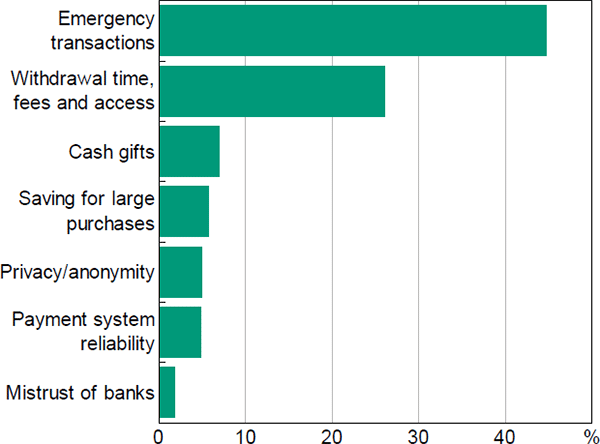
Note: Per cent of respondents who hold cash outside of wallet
Source: RBA calculations, based on data from Ipsos
5.3 Cash Withdrawals and ATM Fees
As Australian consumers use cash less often for their transactions, they are ‘topping up’ their cash holdings less frequently. For the first time since the inception of the CPS, in 2016 the majority of respondents (55 per cent) did not top-up their cash holdings during the week. The average number of top-ups per person fell to 0.7 over the week, compared with 1½ per person in each of the previous surveys (Table 6). People are withdrawing cash from ATMs, bank branches and via the ‘cash out’ option at the point of sale less frequently than in the past.
| 2007 | 2010 | 2013 | 2016 | |
|---|---|---|---|---|
| Share of respondents making one or more top-ups (%) | 86 | 72 | 76 | 45 |
| Number of cash top-ups per person per week | 1.4 | 1.6 | 1.5 | 0.7 |
| Via ATM | 0.9 | 0.9 | 0.7 | 0.4 |
| Via cash out at point of sale | 0.3 | 0.4 | 0.4 | 0.1 |
| Via over the counter at a bank branch | 0.1 | 0.1 | 0.1 | 0.0(b) |
| Via other source | 0.1 | 0.2 | 0.3 | 0.2 |
| Median value of top-ups ($) | 100 | 100 | 60 | 100 |
| Via ATM | 100 | 100 | 80 | 100 |
| Via cash out at point of sale | 50 | 50 | 50 | 50 |
| Via over the counter at a bank branch | 250 | 385 | 100 | 200 |
| Via other source | 85 | 45 | 50 | 50 |
| Share of ATM top-ups attracting a fee (%) | na | 23 | 15 | 8 |
| Average ATM fee ($)(a) | na | na | na | 2.16 |
|
Notes: (a) For withdrawals that attracted a fee Source: RBA calculations, based on data from Colmar Brunton, Ipsos and Roy Morgan Research |
||||
The frequency at which consumers received additional cash from other sources – e.g. cash wages and transfers from friends or family – was also a bit lower than in 2013 but has been broadly stable across different vintages of the CPS. The majority of cash top-ups from other sources were for relatively low values (70 per cent were worth $100 or less), indicating that many are likely to have been person-to-person transfers. The slower decline in the frequency of this type of top-up is consistent with consumers currently having fewer electronic options that replicate the convenience of cash for some person-to-person payments. However, as discussed below, the New Payments Platform (NPP), due to be launched around the end of 2017, will provide a convenient, fast and secure option for person-to-person payments once it becomes operational (see Section 7.3).
When 2016 CPS participants withdrew cash from an ATM – the most common way of topping-up cash – the median amount was $100. Despite a decline in the transactional use of cash, this value has been fairly stable over time (with the exception of a fall in the median value in 2013), implying that each withdrawal is lasting longer. More comprehensive information on cash withdrawals comes from the Bank's RPS, which corroborate the survey findings of a decline in the number of withdrawals (Figure 20). The RPS also show that the total value of ATM withdrawals has fallen at a slower pace than the number of withdrawals, indicating a rise in the average value of each withdrawal since 2007 (which was not observed in the survey data).[25]
Consistent with other datasets, the CPS suggests that people are withdrawing money from ATMs less frequently and paying a fee on a smaller share of these withdrawals.[26] The CPS also provides useful information on the relationship between cash top-up behaviour and demographic characteristics. For instance, it indicates that ATM fees were most commonly paid by lower-income respondents and those living outside of capital cities (potentially due to greater difficulty accessing own-bank ATMs in regional areas).
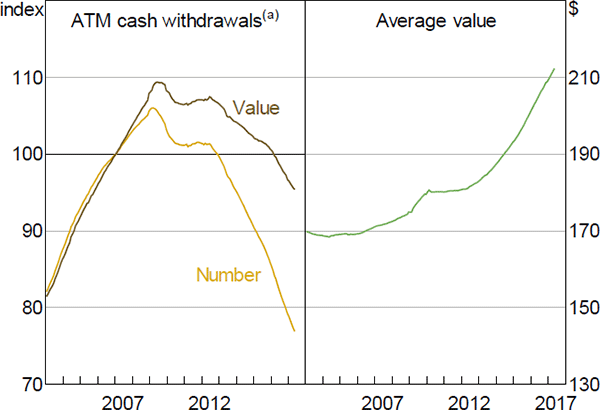
Note: (a) January 2007 = 100
Source: RBA
Footnotes
Stewart et al (2014) found that smaller businesses faced higher card acceptance costs than larger businesses, partly because of smaller economies of scale in back-office processing. They also generally face higher prices for payment services due to differences in bargaining positions and payment needs. [20]
These are the two largest supermarket chains in Australia (Woolworths 2011; Coles 2012). [21]
These figures will reflect both a change in the composition of demographic cohorts (e.g. people moving into different age categories) and a shift away from cash by members of a particular cohort (e.g. older Australians using cash less frequently). [22]
Because of the overlap between age and income groups, the figures for income quartiles are adjusted for respondents' age. Using the previous three waves of the survey, Meredith, Kenney and Hatzvi (2014) found that income was generally not a statistically significant determinant of cash use once other factors were controlled for in a regression framework. [23]
In 2013, respondents were asked about their reasons for all cash holdings (i.e. inside and outside of their wallets). [24]
The average ATM withdrawal value was $192 in the 2016 CPS, an increase from 2013 but little changed from 2007 and 2010. [25]
The incidence of ATM fees recorded in the CPS (8 per cent) was lower than that recorded in the Bank's survey of ATM operators which suggested that the share of ATM withdrawals that incurred a fee was 28 per cent in 2014/15 (Flood and Mitchell 2016). [26]